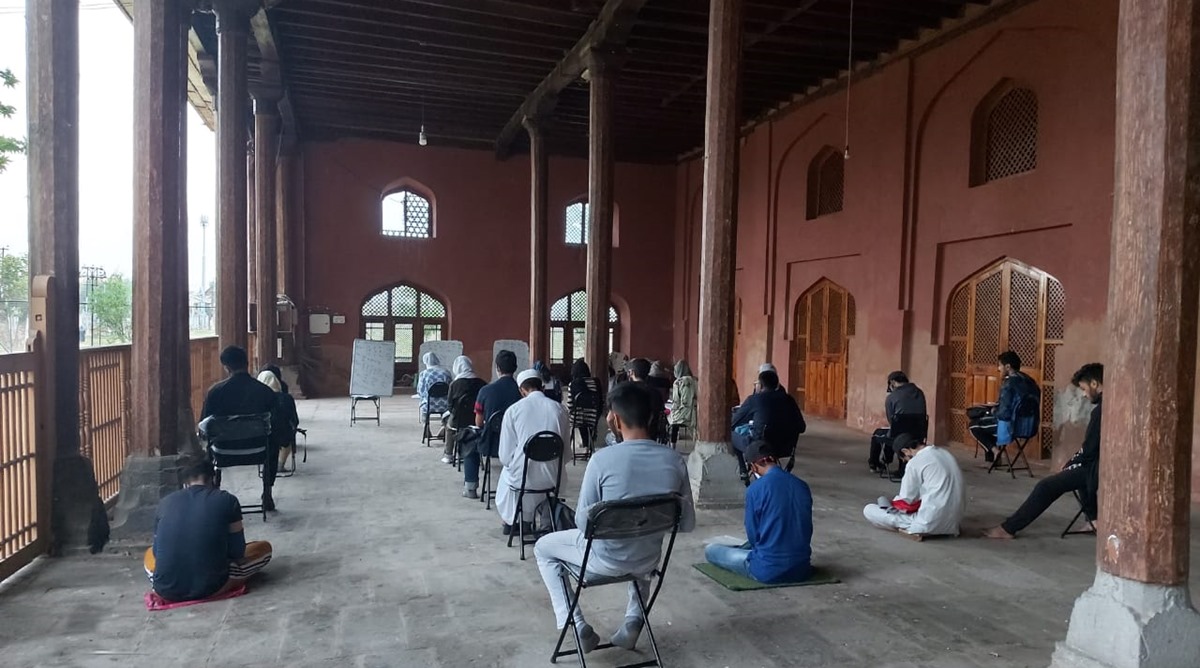
International Literacy Day 2021: Meet teachers who used innovative methods to teach students amid pandemic | Education News,The Indian Express
International Literacy Day 2021: Meet teachers who used innovative methods to teach students amid pandemic
From painting walls in the villages to conducting open-air classes and organising evening schools through young volunteers,
Open-air class being conducted in the verandah of Aali Masjid in Srinagar. (Photo: Muneer Alam)
From working professionals to young students and children, the Covid-19 pandemic has been tough for all. The lockdowns and the subsequent shutdown of schools and higher educational institutes took a toll on the learning process of many students. However, teachers continued to make efforts to reduce the academic loss. In the process of doing so, many across the country and the world innovated unique initiatives to help students continue with their education.
Here are a few of them:
Hand-painted walls as a medium of learning
G Kalavathi, who is the only teacher at Telangana’s Mandal Parishad Primary School in Pochamma Gadda Tanda village of Mahabubnagar district, was concerned about students forgetting the basics amid the pandemic.
“Primary students were not able to cope with online classes, largely because of the lack of digital infrastructure. So, I personally went and painted the walls of students’ houses with the required basic concepts. There are many students who do not live in pucca houses and, thus, there were no walls to paint. For them, I arranged flexi charts. Since the students could not go to school, we decided to bring the school to the students,” said the 42-year-old teacher.
Hand-painted basics at one of the students’ houses. (Photo: G Kalavathi)
Since proper blackboards were not affordable, Kalavathi purchased small and carriable ones that could be placed on tables, chairs and even stairs. Some children also carried chairs from the school to the places where these blackboards were placed. “I also prepared teaching-learning materials (TLMs) and worksheets, which were provided to the students for practising the concepts,” she added.
Open-air classes in Kashmir
Schools and educational institutes in Kashmir have been shut since the abrogation of Article 370 on August 5, 2019. The closure continued with the spread of Coronavirus. With internet lines snapped and education institutions shut, students of the Kashmir valley could not keep up with their learning needs.
For such students, Srinagar-based engineer-turned-teacher Muneer Alam decided to conduct open-air classes in the city. In 1999, while pursuing an engineering course, Alam had lost an academic year because of the Kargil war. This provoked him to work in the education sector because he did not want any other child to face the same problem. He has taught more than 25,000 students in J&K for boards and competitive exams, some for a fee and many for free.
Muneer Alan’s morning open-air class in Srinagar’s Eidgah in 2020. (Photo: Muneer Alam)
“Initially, I invited the students to my house but it was not possible to accommodate all of them. I did not want students to lose an academic year, hence I started conducting free open-air classes in Srinagar city’s Eidgah. With only a few students in the beginning, the open-air classes started to attract many from far-flung areas. I started taking classes as early as 4:30 am and continued till sunrise. Students brought their own chairs and sat at a distance of around four metres to maintain social distancing,” said Alam, who graduated from the Regional Engineering College, which is now National Institute of Technology (NIT), Srinagar.
He claims to have received two threat letters in August 2019 for conducting the classes but nothing could taint his spirit. “The unrest in the region impacts the future. Education is the only way that these students can make a better life for themselves,” said Alam, who has been nominated for the Global Teacher Prize 2021 by the Varkey Foundation.
Community participation
Since teachers could not allow students to come to schools and even they could not reach all students, some decided to utilise the local human resource in the villages.
In Odisha’s Kalahandi district, Naveen Kumar Saraf decided to recruit volunteers to teach students across the village. Saraf is an assistant teacher at the Nandgaun Government High School, situated 78 km from the district headquarters in Dharamgarh block.
“Amid the pandemic, it was getting difficult for students to keep up with studies. I reached out to a few college students of the village to volunteer since they were also taking online classes amid the pandemic and had some free time. Initially, they were all concerned about what they would be getting out of it and only one volunteer signed up. Later, the evening classes created a buzz across the community and more volunteers started contacting me on their own. We had a total of 12 volunteers who taught around 10-15 students in different parts of the village,” said Saraf.
One of Saraf’s volunteers taking a class in Odisha’s Kalahandi district. (Photo: Naveen Saraf)
He added that there were many challenges but the children and volunteers did not lose their spirit of continuing with the classes. “Sometimes, the heavy rains in Kalahandi would bar volunteers from conducting classes in the open. Besides, the fear of contracting the virus was constant for everyone. But the college students decided to solve these problems with the support of other community members and teachers,” Saraf said, who believes active community support is required to strengthen the education system.










